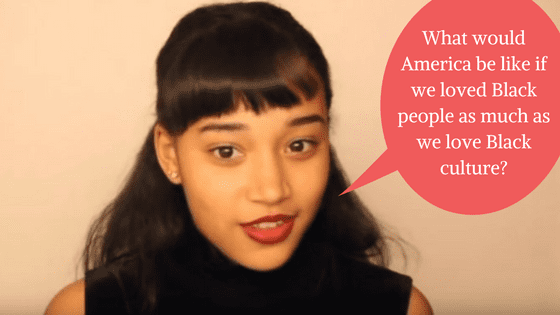In a Facebook fiction writers group, a white man started a discussion on “cultural appropriation” (his quotes). In short, he claimed that it’s not real and writers should write whatever they want. In the comments, the mostly-white folks agreed.
Cultural appropriation in writing is a serious topic worthy of discussion. Unfortunately, that was not the purpose of the thread. It was just a white man seeking permission to be irresponsible and racist and a group of white people who gave him and each other validation.
I suspected that the thread would spiral out of control and reported it to the group admin (a white man from Georgia). He didn’t see anything wrong with it despite comments that included:
“I would find it amusing to be accused of cultural appropriation by someone using a computer, made with plastic powered by electricity, which were all invented by my culture.”
“One of my main characters was a dolphin. Researched but there’s not much on talking dolphins, and I’m not a dolphin.”
“Yeah, colored people can use whatever they want and not allowing it is racist, but whites can only be whites. Not fair.”
“To assume that I can’t put myself in Geisha shoes because I’m not Japanese, is just silly to me. Isn’t being human the point?”
“Tupac wore a cross necklace while rapping about killing people and selling drugs.”
“This topic doesn’t ‘spark discussion’. It exposes the festering wart that’s currently crippling western society: A Marxist infestation of identity politics that’s lead to awful behaviour from anyone that society deems a minority (Mindless feminists and racist BLM freaks etc). It has poisoned literally everything.”
One white woman said she is Canadian and her historical novel features a German protagonist and nobody has ever complained or accused her of cultural appropriation, completely misunderstanding the concept.
One white man said to a Black man and to me that we don’t understand cultural appropriation. He said it isn’t real, but rather a racist attempt to take ownership of ideas that don’t belong to anyone. He added that white people are fighting a “bigger war” and we should try to understand.
It was a missed opportunity to explore a real issue.
What is cultural appropriation?
Cultural appropriation is the adoption or use of elements from cultures other than your own. It is free of judgement. It can be positive when it involves cultural exchange and cultural sharing. When it is harmful, it is cultural misappropriation. Cultural appropriation and cultural misappropriation are often used interchangeably, which creates confusion. Keep that in mind and try to examine the context when these expressions are used.
Cultural misappropriation happens when a dominant group uses elements from the culture of people who have been oppressed by that dominant group without permission. It is a form of oppression and exploitation due to power imbalance.
Examples of cultural misappropriation can be easily found in art, music, fashion, and religion. It’s when white people with no ties to indigenous communities run sweat lodges and fashion stores sell cheap dream catchers made in China. It’s when a Victoria’s Secret model wears a Native American-style feathered headdress with fringed leather bra and panties and high-heeled moccasins. It’s when Kylie Jenner posts an Instagram selfie of herself with cornrows. It’s when Katy Perry dressed up as a Geisha for her performance at the American Music Awards.i Kunzru
Why is cultural misappropriation wrong?
These are not homages or imitation as flattery. It’s exploitation by members of a group with a recent history of oppressing members of the group they are “borrowing” from. Again, power is important to understanding cultural misappropriation.
Miley Cyrus, a wealthy white woman from the south, told Billboard Magazine she loves “hood music”. A white artist like Cyrus is celebrated and called “edgy” for twerking on stage. Meanwhile, the appropriated group is demonised and excluded for the same cultural element. As Amandla Stenberg wrote in response to Jenner’s cornrows, “While white women are praised for altering their bodies, plumping their lips and tanning their skin, black women are shamed although the same features exist on them naturally.”
Unlike cultural sharing, cultural misappropriation is not a process of equal and mutually beneficial exchange. Cultural misappropriation reinforces stereotypes, fetishises people, and robs minority groups of the credit they deserve. It also ignores the challenges that minorities face. In a political climate in which Mexicans are demonised, discriminated against, and called for deportation, white people wear sombreros on Cinco de Mayo and on Halloween and paint their faces for the Day of the Dead. Writer Aya de Leon wrote:
“As they drink and dance in white-organized and dominated Dia De Los Muertos celebrations without a thought for us, except perhaps the cleaning or custodial staff that will clean up after them, we Latin@s learn what we learned in 1492 about the invaders: you want the golden treasures of our culture, but you don’t want us.”

Cultural appropriation in writing
Cultural misappropriation is easy to identify in music and fashion, but what about in writing? There are two major forms of cultural appropriation in writing. One is writing about minorities. The other is writing in the voice of someone from a cultural minority.
The lack of culturally diverse characters in fiction contributes to erasure. Writers should create characters from different races, cultures, class backgrounds, and genders. Writing is about imagination, exploring otherness, and creation. It is normal for writers to want to write characters like themselves and also unlike themselves. That’s not the issue. Speculative fiction writer, media critic, and culture columnist K. Tempest Bradford explains:
“You won’t find many people advising authors to only create characters similar to themselves. You will find many who say: Don’t write characters from minority or marginalized identities if you are not going to put in the hard work to do it well and avoid cultural appropriation and other harmful outcomes. These are different messages. But writers often see or hear the latter and imagine that it means the former.”
Writing is about exploring the subjective experience of an imagined other, but this requires humility. For a white writer to believe that they can meaningfully inhabit the perspective of someone from a fundamentally different background is arrogant and strange. Would you tell someone dying of cancer that you know what they’re going through or a war veteran that you understand their PTSD?
Bradford asks writers to consider whether they are acting as Invaders, Tourists, or Guests, a framework developed by author Nisi Shawl. They both teach and write about inclusive fiction at Writing the Other. Bradford also has an excellent primer on the subject. Australian writers may also be interested in the protocols for working with Indigenous artists published by the Australia Council for the Arts.
"Isn't being human the point?"
In short, no.
One woman in that Facebook group discussion said cultural appropriation is not an issue for her. Of course, it isn’t. She belongs to a dominant group that has had the historical liberty to participate in cultures freely and that has been allowed to misrepresent minority cultures for a very long time. She ignores a long history of colonisation and the legacy of that – current power structures, politics, advantages and disadvantages.
Writers of colour struggle to tell their own stories and get published. Meanwhile, white authors dominate all aspects of the publishing industry and are rewarded critically and financially for telling the stories of people of colour. Memoirs of a Geisha and The Help are two examples.
There is a cultural shift happening. Writers of colour are challenging cultural appropriation. Publishers want work by writers of colour (or so they claim). Raising objections means challenging racial supremacy and this provokes anger. That’s the “bigger war” the white male writer in the Facebook group was referring to.
“It does not seem like a particular infringement of liberty to pass through the world without being its owner, unless someone else is continually asserting property rights over the ground beneath your feet. The panicked tone of the accusations of censorship leads me to suspect that what is being asserted has little to do with artistic freedom per se, and everything to do with a bitter fight to retain normative status, and the privileges that flow from it.” -Hari Kunzru

